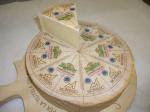Cabrales is produced in the rugged mountains of the Asturias region of Spain and is DOP Certified.Traditionally the cheese was produced from the local milk of cows ,goats and sheep and then wrapped with sycamore leaves. However, most of the Cabrales that we see in the United States today is made solely from cow's milk and is wrapped in foil. This Spanish blue cheese is made in the spring and summer using centuries old methods of production and aging.
Spanish Cheese Sampler at Amazon
Spanish Cheese Sampler at Amazon
Details: The locally collected milk is allowed to sit for three to four hours before goat rennet is added and the curdling process begins. The curds are then molded into 5lb wheels and set in caves to age. After about a week the young cheeses are pierced with steel needles to allow the natural bacteria in the caves to seep into the white paste. This produces.veining in the interior paste that is very intense and tends towards being purple in color. It should be noted here that Cabrales is not made by injecting penicillium mold so it's veining is natural. The curing process proceeds from the outside (the rind) to the inner paste, thus producing an inedible natural rind that can look very unsightly and is extremely salty. The local limestone caves provide the perfect environment for aging this great cheese at 45-55F and 90% humidity. The normal aging process lasts from two to six months however, the Cabrales that is imported into the United States is aged about 2 months and has a mellower flavor the longer aged cheeses. If after trying Cabrales you find it to be overpowering you can substitute Stilton for it.
Tasting notes:The aroma and flavor of Cabrales are strong and pungent, this cheese is not for the weak hearted. The flavor is explosive and powerful with a decidedly salty note and a spicy finish. As the cheese ages the the salty flavor will increase, the veining will get darker and pockets of crystalized amino acids will begin to form, all of this adds several magnitudes of intense flavor and aroma.
When shopping for Cabrales look for cheeses that have a clean light yellow crumbly but moist interior paste and thick veining. If the interior paste is gray or is oozing it is a sign that the cheese is past its prime and will be a very unpleasant purchase.
Serve Cabrales with sweet fruits like grapes figs or melons and crusty bread for brunch. It also livens up all vegetable salads and pairs well with almonds and walnuts. Cabrales is an excellent blue cheese for melting over grilled or roasted meats. Mashed with a bit of unsalted butter or heavy cream, it is delicious served as a spread for baguette slices, crackers, or fruit.
Serve Cabrales with sweet fruits like grapes figs or melons and crusty bread for brunch. It also livens up all vegetable salads and pairs well with almonds and walnuts. Cabrales is an excellent blue cheese for melting over grilled or roasted meats. Mashed with a bit of unsalted butter or heavy cream, it is delicious served as a spread for baguette slices, crackers, or fruit.
Wine Paring: Strong Spanish reds like el Bierzo, Navarra, Rioja and sweet or dry Spanish Sherries.








